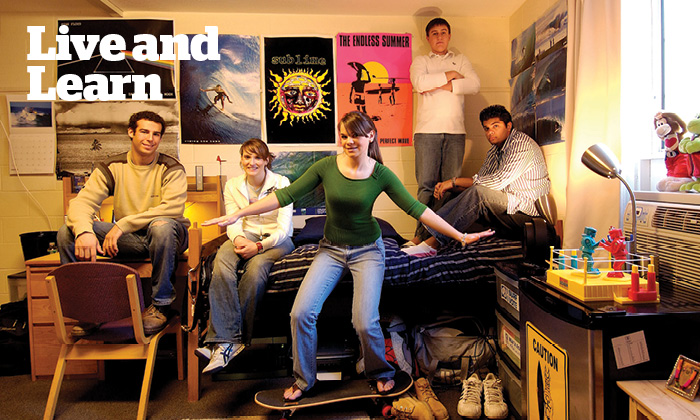
It is fitting that the student affairs profession took shape in the early 20th century, just as Harry Bentley was starting his own educational endeavor. Our founder cared very much about students’ development as professionals and for them personally (in 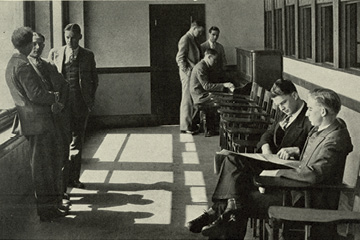 lending money to those in need, for example). The sentiment carries through our history, more evident now than ever as we aim to develop students who go on to have great careers and great lives.
lending money to those in need, for example). The sentiment carries through our history, more evident now than ever as we aim to develop students who go on to have great careers and great lives.
True to form, Bentley approaches student life with a distinctive philosophy. An education here was never meant to separate students from the real world, but rather to prepare them for that world — whether at work or at home. By helping students form relationships, develop autonomy, balance emotions, discover what inspires them and, of course, celebrate their successes, we graduate alumni who are more engaged at work and report higher levels of well-being than their national peers, according to a survey by Gallup Inc.
ROOM TO GROW
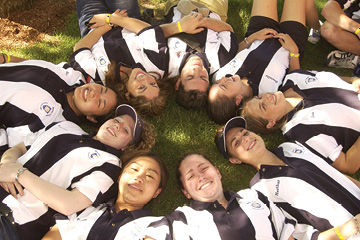 Until the 1960s, student life outside the classroom was virtually nonexistent. Becoming a four-year college spurred change and the new Waltham campus made room — literally — for wide-ranging programs and activities.
Until the 1960s, student life outside the classroom was virtually nonexistent. Becoming a four-year college spurred change and the new Waltham campus made room — literally — for wide-ranging programs and activities.
Today, student life is a key element of the university’s strategic plan, recognizing the educational value of a fully immersive residential experience for undergraduates.
Opportunities come in many forms: living and learning communities in residence halls, such as the Global Living Center or the Women’s Leadership floor; social activities nearly every night of the week; concerts that boast an attendance of 3,000; spirited hockey games; a signature trip to the Bahamas just before Commencement.
Students themselves are strong partners in shaping campus life. They serve as effective advocates for their community, balancing academics with opportunities to gather around common interests and causes.
Looking back and ahead, student life is rooted in three commitments: engineering change, building community and developing services. A handful of stories illustrate these themes.
"... there needed to be embracing of an athletic program. Bowling on Wednesday afternoons with [Accounting] Professor Harry Zerigian, while a delightful break, would not suffice!”
— David G. Kennedy ’65
RAISING SCHOOL SPIRIT WITH ATHLETICS
An athletics program did not exist at Bentley until the early 1960s. This was due in part to a lack of space on the Boston campus, but also because students were encouraged to devote themselves fully to academics.
It was students who lobbied for change. David G. Kennedy ’65 shares his pride in “convincing the triumvirate of [Thomas] Morison, [Rae] Anderson and [E. William] Dandes — with an assist from [Henry Y.] Porter — that as Bentley was about to transition to collegiate standing with a vision for a ‘real’ campus, there needed to be embracing of an athletic program. Bowling on Wednesday afternoons with [Accounting] Professor Harry Zerigian, while a delightful break, would not suffice!”
Most recently, students were staunch advocates for the multipurpose arena rising on the south campus. The Student Government Association was instrumental in proposing the venue to trustees. The facility will host events such as concerts, academic lectures, and career and activity fairs, along with providing a first-ever home for the university’s Division I hockey team.
STANDING UP FOR DIVERSITY
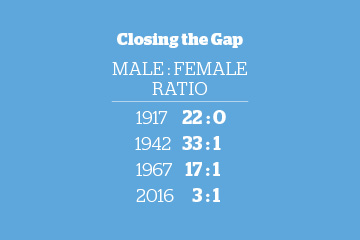 Unlike the university today, Bentley was an all-white school until the 1930s and men only until 1942 (though women were admitted for a brief period during World War I). Sadly, enrollment reflected the workplace of the time, as employers rarely hired either women or men of color as accountants.
Unlike the university today, Bentley was an all-white school until the 1930s and men only until 1942 (though women were admitted for a brief period during World War I). Sadly, enrollment reflected the workplace of the time, as employers rarely hired either women or men of color as accountants.
Still, the school strived to be an inclusive place for women and students of color. The Black United Body, established in the 1969-1970 academic year, is one of Bentley’s oldest student organizations. Student groups now represent and support a wide range of cultures and ethnicities. Students have been at the center of ensuring tolerance on campus. An incident of intolerance in the 1990s, when posters for cultural organizations were defaced and torn down, demonstrates this. Bob Minetti, retired vice president for development, corporate and alumni relations, shares this story.
“Following the incident, a group of students organized a nighttime walk around campus to post flyers with the message ‘This is our home. Bigots not welcome.’ It not only brought the campus together but forced the institution to confront racial issues. It was phenomenal because the student body enlisted the support of faculty and staff; they saw Bentley as their community.”
My immediate predecessor as vice president, Kathleen Yorkis, was an early supporter and leader of the Multicultural Center. She credits the center for “providing support to a great community, whose presence contributes to the cultural richness of Bentley as a whole.” Today, with the Center of Women in Business and programs like Bentley Brave, we move from reflecting the workplace to influencing the workplace.
BUILDING COMMUNITY
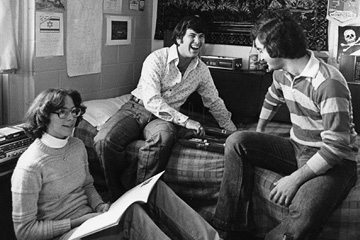 Fraternities and sororities, established at Bentley in the 1920s and 1940s, respectively, had a large influence on social life. Their fundraisers, dances and annual banquets presented opportunities for connection.
Fraternities and sororities, established at Bentley in the 1920s and 1940s, respectively, had a large influence on social life. Their fundraisers, dances and annual banquets presented opportunities for connection.
Campus-wide events have been important community builders, and none more so than Spring Day. It marks the end of classes and serves as a last hurrah before finals begin. The event started with carnival rides on the library quad before moving to Greenspace and featuring local musicians (though one year a rainstorm relocated revelers under the Miller Hall parking deck). Spring Day now centers on a concert by well-known musicians that is held in the Dana Center. The theme of friendship and community connects all of these iterations.
President Greg Adamian often said, "After we’ve taught you everything there is to know about money, we’ll teach you that money isn’t everything."
DEVELOPING SERVICES
Bob Minetti and Kathleen Yorkis were instrumental in building the professionalism of the Student Affairs division. Their work took Bentley from a “suitcase campus” to one that operates 24/7. Accordingly, the commitment to student life stretches across the organization. Collaborators have included faculty, according to Bob. “I’m hard-pressed to recall a time when I didn’t receive support. Faculty respected work we were doing, which was rather unique. They understood that what happened outside the classroom was important, too.”
The support came from the top, Kathleen Yorkis recalls. “President Greg Adamian often said, ‘After we’ve taught you everything there is to know about money, we’ll teach you that money isn’t everything.’ To me, that was a powerful statement about student life, as a complement to academic accomplishment.”
This approach extends to the services provided by University Police, where Kathleen believed relationships were key. “We did not just hire people who wanted to be cops. We hired people who wanted to subscribe to a community policing model in an educational setting.”
In health care, we have progressed from one nurse hired on a contract basis to today’s Center for Health, Wellness and Counseling. While we hope someday to have a stand-alone wellness center, the staff work in concert to promote students’ physical and mental well-being.
A VITAL PARTNERSHIP
Working with students day in and day out as vice president for student affairs, I have plenty of experiences that speak to their active role in campus life. But there is a single story that demonstrates the spirit of partnership: the senior class trip to the Bahamas.
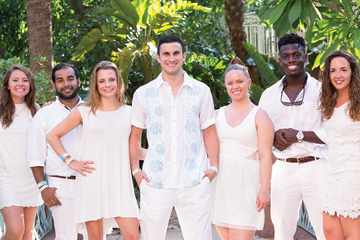 Commencement Week has been a long tradition — a time of fun but also practicality, by giving time to certify grades before commencement. In the mid-1990s, it seemed like the sun and warm weather of May lasted only while students were taking finals. As soon as Commencement Week came, it would get cold and rainy. We tried to find events that would keep students entertained, for example, a field day at the Meadows in Connecticut or trips to Newport. Still, in the end, students came back to a wet, cold campus; the result was some bad behavior.
Commencement Week has been a long tradition — a time of fun but also practicality, by giving time to certify grades before commencement. In the mid-1990s, it seemed like the sun and warm weather of May lasted only while students were taking finals. As soon as Commencement Week came, it would get cold and rainy. We tried to find events that would keep students entertained, for example, a field day at the Meadows in Connecticut or trips to Newport. Still, in the end, students came back to a wet, cold campus; the result was some bad behavior.
Bentley could have chosen to simply eliminate the program. In fact, many peers did. But one of the events — an overnight cruise on the Scotia Prince — showed us how much students enjoyed being away with all their friends. Attempts to arrange a five-day cruise did not pan out, but we found a resort willing to host Bentley’s senior class in 1999. The Bahamas trip was born.
Today’s trip looks very different from the early years. More than 600 students attend and activities include community service on the island. One highlight is the police escort from the Atlantis resort to the home of the island’s governor general, who welcomes Bentley students and thanks them for their commitment to service.
To me, the story underlines a central tenet of student life at Bentley — a commitment to work with students and do so in a way like no other school.
J. Andrew Shepardson is vice president for student affairs and dean of students. The narrative draws on research by university historian Cliff Putney.

